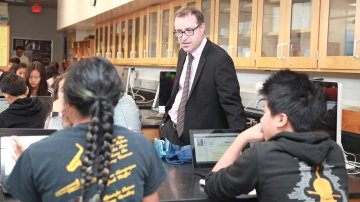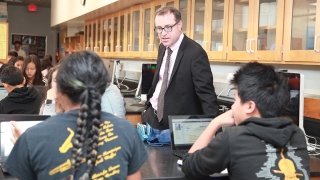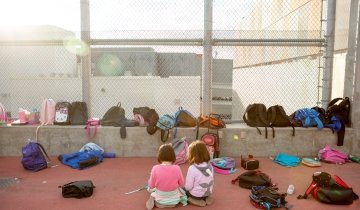Of California’s 1,100 school districts, no two are alike. So why would they all follow the same approach for deciding how to allocate funding? That’s the thinking behind the Local Control Funding Formula (LCFF), which ushered in sweeping changes to the state’s K-12 resource distribution. Case in point: the San Marino and Rialto school districts.
With two elementary schools, one middle school and one high school, the San Marino Unified School District educates some 3,000 students in a leafy, predominantly residential suburb with wide, well-maintained streets, plentiful parks and gardens and some of the most expensive home prices in Los Angeles County. Low-income students make up fewer than 5 percent of overall enrollment, which is overwhelmingly Asian and white, reflecting the San Marino demographics.
Some 50 miles inland to the east, in San Bernardino County — a major industrial center — enrollment at the 26,000-student Rialto Unified School District mirrors the community’s largely Latino population, with Rialto High School’s student body, for instance, at 89 percent Latino. While the 29 different schools comprising the district vary demographically, all maintain relatively high percentages of low-income students and English-language learners. As an example, the district’s Sam V. Curtis Elementary School includes 43 percent English-language learners, with 85 percent of its student body coming from low-income families.
PRIORITIZING NEED
When LCFF passed — giving school districts much more freedom in allocating resources — Alex Cherniss EdD ’08, was chief financial officer for the Los Angeles County Office of Education. There he oversaw 81 school districts and was a strong advocate for the new funding model, which prioritizes low-income students, English-language learners and foster youth. Now superintendent of the San Marino Unified School District, he also teaches school finance at USC Rossier, giving him a broad outlook on the subject.
“From a practical perspective, more money is flowing to districts with a higher percentage of students that qualify for funding based on language or other needs,” Cherniss explains. “At San Marino, we don’t have a high degree of students on free or reduced-price lunch, so the funding we receive is easily 30 percent to 40 percent less per student than, say, in L.A. Unified.”
Implementation of LCFF coincided with a California ballot initiative — Proposition 30 — that halted a large funding cut. Nonetheless, districts like San Marino often must seek philanthropic support from foundations, individual parents and the Parent Teacher Association to raise money to reach the state’s average level of funding. San Marino receives approximately $7,500 per student compared with the $10,000 state average.
For 14 consecutive years, San Marino was the state’s highest-performing school district under the former accountability measurement system, the Academic Performance Index. It remains a top performer under the new system, although LCFF does not rank districts or individual schools.
The district emphasizes “the three A’s”: academics, athletics and arts, and is expanding its curricular offerings in science, technology, engineering and mathematics (STEM). While many districts have had to cut back on arts education, San Marino prides itself on being a champion of the arts, with extensive programmatic offerings in band, choir, dance, drama, instrumental music and more. Much of that support comes from philanthropy, and the district is actively raising money for its new Barth Athletics Complex.
“It’s a challenge,” Cherniss says, noting that San Marino recently passed a parcel tax to help fund its school district. “We’re doing everything we can to have an adequate level of funding close to what the average school district in California receives.”
LOCAL CONTROL
Superintendent Cuauhtémoc Avila EdD ’11 took the helm of the then-troubled Rialto Unified School District in 2015. He is widely credited with launching a significant turnaround for the district, with two schools garnering California Gold Ribbon recognition and programs at several others winning awards.
Due to its high concentration of low-income students and English-language learners, the district now receives an additional $66 million a year through LCFF, which is helping the Rialto district focus on three priorities: early childhood literacy, pre-K through third grade; college and career readiness with an emphasis on science, technology, engineering, arts and math (STEAM); and ongoing professional development for teachers. He says a remaining challenge is encouraging teachers in his district to let go of past practices or programs that are not showing desired results.
However, for Avila, the most important provision of LCFF has been the local control aspect — not the increased funding. The previous resource allocation formula was so restrictive and complicated that it tied the hands of local districts to serve the unique needs of their students, he says. “You couldn’t use the money where you really needed it.” He also took the concept of local control a step further, giving principals in the district more authority as well.
The newfound flexibility, however, has brought its own challenges. The Local Control and Accountability Plan (LCAP) — a centerpiece of LCFF — lacked clarity in purpose and structure. It was intended to serve as a device for strategic planning as well as community engagement but, in many parts of the state, has been used as more of a compliance document.

The state continues to refine the LCAP, with input from education leaders and scholars from USC Rossier, including Associate Professor Julie Marsh and postdoctoral fellow Michelle Hall PhD ’16, who co-authored a report in April for the LCFF Research Collaborative.
“Our findings point to some clear areas where the state and districts need to make adjustments,” Marsh says. “Districts need help in understanding the intent of the policy and more support in key areas, such as how to relate investment decisions to outcomes, how to evaluate progress toward goals and how to broaden and deepen stakeholder engagement.”
“Because it was local control, there was so much interest it almost seemed like an internal free-for-all fight for resources,” Avila says. “We had so many areas we wanted to focus on as a district that it was difficult to home in and prioritize.” Still, he notes, the resulting process was a positive one. “It opened up a lot of discussion. Then you come up with a viable program that’s going to really benefit the kids in the community.”
ADEQUACY VERSUS EQUITY
Despite benefiting from the new formula, Avila agrees that additional funding is needed throughout the system. “Because one of the eight target areas of the new law is to provide a quality staff, an immediate focus was the statewide demand — as we came out of the recession — to provide pay increases to staff. It limited the money that would be used to provide programs directly to kids,” he says.
Personnel expenses can be as high as 80 percent of a district’s overall budget, Cherniss notes. “It’s hard to measure how much has gone to other things that improve the education of the kids, like technology or lower class sizes,” he says.
“California public education is underfunded,” he adds. “We’re clearly in the lower tier of per-pupil funding in the United States. Districts are having to make huge increases in retirement contributions every year, and it’s beginning to outstrip their annual revenues. Many districts right now are deficit-spending.”
He shares the example of the Inglewood Unified School District’s bankruptcy — the result of long-term deficit spending — which had to be resolved through a state loan. “If funding slows down, we could see another really challenging time for public schools,” he says.
“In my Rossier classes, we talk a lot about adequacy versus equity,” Cherniss says. “We need to make sure that all kids in the state are getting adequate funding. Equity is critically important as well. Many districts face a lot of real challenges, so there’s a lot of justification for large urban districts to have more funding than other districts. I see both sides of it.”
“We definitely could do a lot more with more money,” Avila says. “But that’s not always the answer. You can pour money into problems and still end up with the same results if you don’t come up with a viable plan and commit yourself to it. It’s really about the practices, and developing the strategic planning that can make your practices more effective.”
LOOKING FORWARD
While Cherniss notes that districts ranking high in standardized test scores typically have been located in more affluent communities, the state has developed indicators — the new California School Dashboard — that show performance isn’t necessarily tied to socioeconomics.
“The goal is to change the paradigm of how we identify high-performing schools,” he says. “There are great schools all over Los Angeles and throughout the state that are not in high socioeconomic communities. It’s hard to capture the reasons why certain school districts are high-achieving. It’s not all about dollars and cents.”





